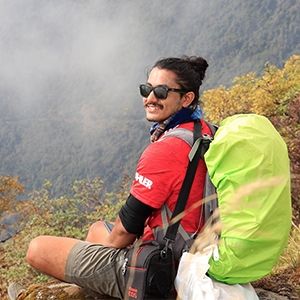The 12 National Parks of Nepal are:
CHITWAN NATIONAL PARK
Formally known as Royal National Park which is now renamed as Chitwan National Park situated in the plains of terai is the very first National Park of Nepal declared in the year 1973 from the approval of Late King Mahendra covering the area of the entire Chitwan district of 952sq.km at an altitude of 200m from sea level. Granted as UNESCO World Heritage Site in the year 1984. Situated in the southern part of Nepal 100 km from the capital city Kathmandu. This 1st National Park of Nepal is globally renowned for preserving the last population of One-Horned Rhinoceros and the last refugees of Bengal Tigers.
A glance of Flora in Chitwan National Park
- 70% of the land is covered by sal trees including Chir Pine (Pinus roxburghii), Beleric (Terminalia bellirica), Rosewood (Dalbergia sissoo), Axlewood (Anogeissus Latifolia), Elephant Apple (Dillenia Indica), Grey Downy Balsam (Garuga Pinnata), and Bauhinia Vahlii & Spatholobus Parviflorus creepers.
- 20% of the land is covered by grasslands.
- 50+ types of grasses including elephant grass (Saccharum Ravenna species which can grow up to 8cm), Giant Cane (Arundo Donax), Khagra Reed (Phragmites Karka), etc.
- One of the first grass Kans Grass (Saccharum spontaneum) gets washed away in the monsoon floods.
- Variety of shrubs like Velvety Beautyberry (Callicarpa Macrophylla), Hill Glory Bower (Clerodendrum Species), and Gooseberry (Phyllanthus Emblica).
A glance of Fauna in Chitwan National Park
- 700+ species of Wildlife.
- 50+ species of Mammal like Sambar, Hog Deer, Barking Deer, Spotted Deer, Wild Boar, Nilgai and Guar (Indian Bison), Indian Pangolin, Chinese Pangolin, Bengal Fox, Tarai Gray Langur, Golden Jackal, Asiatic Wild-dog, Sloth Bear, Indian Grey Mongoose, Small Asian Mongoose, Crab-eating Mongoose, Common Leopards, Bengal Tiger, Clouded Leopard, Leopard Cat, Wild Boar, Asiatic Elephant, Four Horned Antelope, etc.
- 525+ species of Birds like Black Francolin, Red Junglefowl, Kalij Pheasant, Ruddy Shelduck, Grey-headed Woodkeeper, Himalayan Flameback, Coppersmith Barbet, Oriented Pied Hornbill, Common Hope, Red-headed Trogon, Common Kingfisher, Blue-tailed Bee-eater, Indian Cuckoo, Emerald Dove, White-breasted Waterhen, etc.
- 55 species of Amphibians and Reptiles
- 17 species of Snakes, Tortoise and Lizard
- 113 species of Fish and Mugger Crocodiles in the Narayani River System.
Things to do/explore in Chitwan National Park
- Jungle Safari
- Nature Walking tour
- Cultural Tour
- Bird watching
- Elephant Back Safari
- Elephant Breeding Centre
- Elephant Bathing
- Canoe Ride
- Crocodile Breeding Center
When is the best time to visit Chitwan National Park?
Normally, you can travel to Chitwan anytime during the year. But, scenery-wise, October to December ( which we normally called as autumn season) and May to July ( which we normally called as Spring season is the time to explore around the Chitwan National Park.
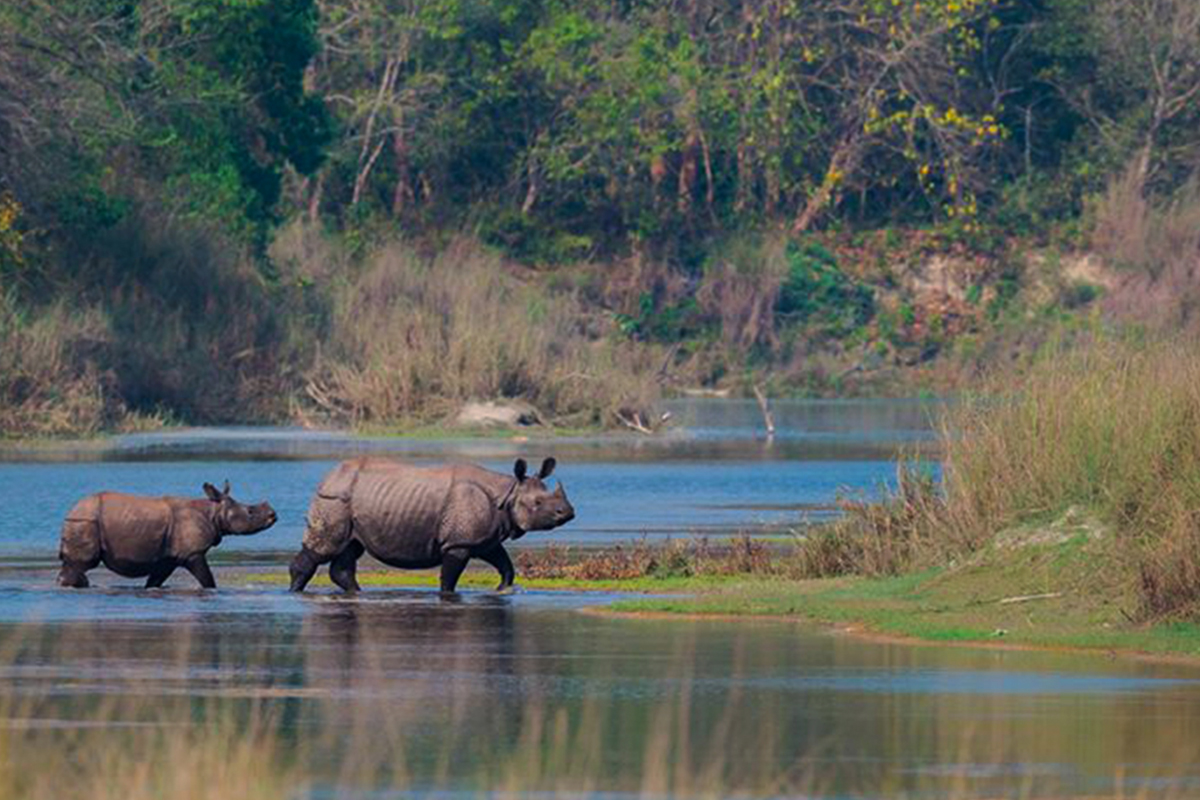
Entry Fee / Permits for Chitwan National Park
- SAARC countries Foreigners = NPR 750 + 13%VAT/day
- Foreigners outside SAARC = NPR 1500 + 13%VAT/day
- Citizen: NPR 100 + 13%VAT/day
- Children below 10 years: Free
How to get to Chitwan National Park?
- By Air: Kathmandu - Bharatpur 20min
- By Bus: Kathmandu - National Park 5+hrs
- By Private Vehicle: Kathmandu - National Park 5+hrs
SAGARMATHA NATIONAL PARK
Sagarmatha National Park established in 1976 A.D is the first National Park of Nepal declared as the World Heritage Site by UNESCO in 1979 A.D covering an area of 1,148 sq. km at an altitude of 6,000 m from sea level. It is the only National Park situated at the highest elevation and home to the world's highest peak Mt. Everest.
A Glance of Flora in Sagarmatha National Park
- 69% barren land, 28% grazing land, and 3% forested.
- 6 vegetation zones characterized as lower sub-alpine above 3,000m, Upper sub-alpine above 3,600m, upper alpine 4500m, sub-nival zone about 5,750-6,000m, shrub layer up to 5,000m, and permanent snow line about5,750m.
- Lower sub-alpine consists of blue pine forest, east Himalayan fir, and drooping junipers.
- The Upper sub-alpine consists of birch-rhododendron forest including Himalayan birch, and rhododendron campanulatum.
- The upper-alpine is all about grassland and dwarf shrubs.
- The sub-nival zone includes cushion plants.
- Variety of herbs including Gentiana prolata, G. stellata, edelweiss Leontopodium stracheyi, Codonopsis thalictrifolia, etc.
A Glance of Fauna in Sagarmatha National Park
- 152 species of bird including blood pheasant, robin accentor, white-throated redstart, grandala, rosefinch, ferruginous duck, wood snipe, bar-headed geese, yellow-billed chough, etc.
- 28 species of mammals due to their geography including grey langur, jackal, the grey wolf, Himalayan black bear, Red panda, yellow-throated marten, snow leopard, Himalayan musk deer, Himalayan tahr, Himalayan goral, web-footed water shrew, Himalayan water shrew, short-tailed mole, wooly hare, Bobak marmot, Royle's pika, rat, and the house mouse, etc.
- 6 amphibians & 7 reptiles.
- 26 species of butterflies
- Protected Animals are Red Panda, Musk Deer, Snoe Leopard, Wild Yak, and Gray Wolf.
- Protected Birds are Impeyan Pheasant and Crimson Horned Pheasant.
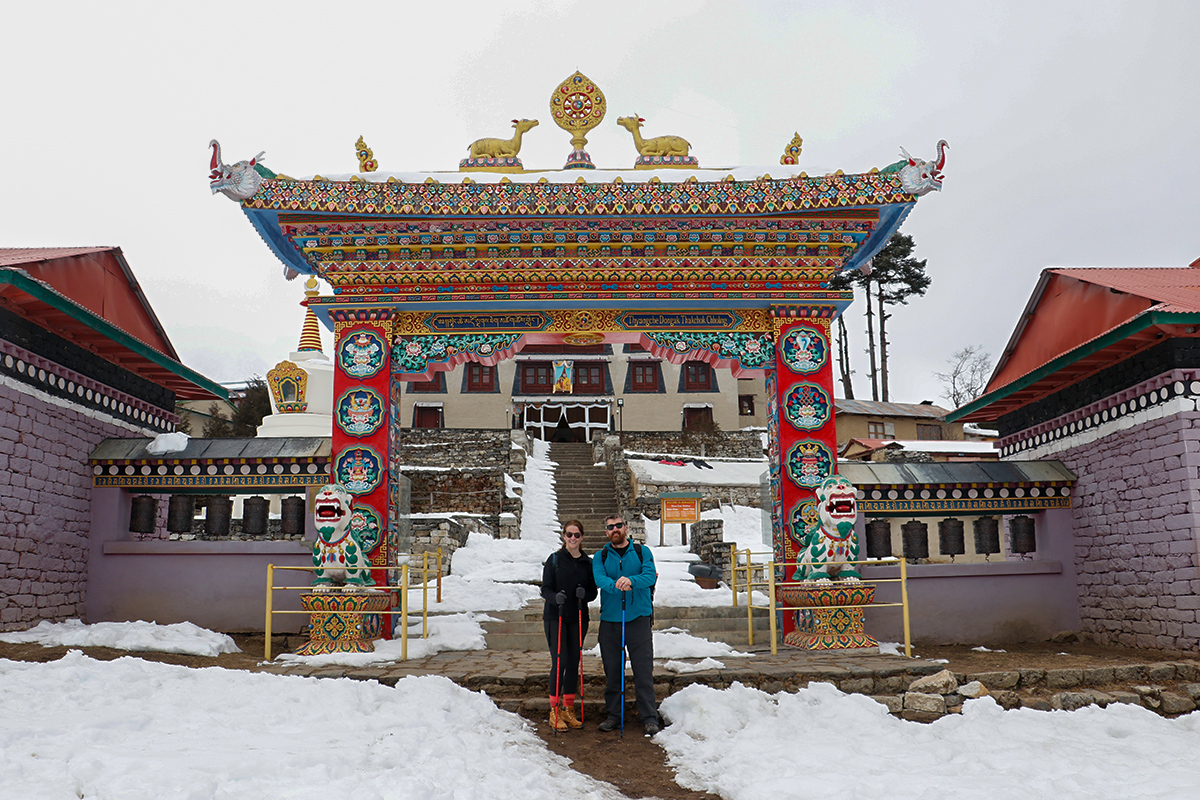
Things to do/explore in Sagarmatha National Park
- Various treks of your choice like Everest Base Camp Trek, Everest Panorama Trek, Gokyo Valley Trek, High Pass Trek, and Cho yu Base Camp Trek.
- Peak Climbing
- Rock Climbing
- Spiritual Trek
- Helicopter Tour & Treks
- Day tour by chopper
- Expedition of high mountains
- Birdwatching and Photography
- Khumbu glacier
What is the best time to visit and explore Sagarmatha National Parks?
Sagarmatha National Parks elevation starts from approx. 2,600m to 8.848.86m, so you can explore the diverse things around the year. But, scenery-wise, October to December ( which we normally called as autumn season) and May to July ( which we normally called as Spring season is the time to explore around the Sagarmatha National Park. Normally, the National Park is more popular for the Everest Base Camp trek, and for trekking in Nepal's high mountains, the spring and autumn season is the best season.
Entry Fee & Permits of Sagarmatha National Park
- SAARC countries Foreigners = NPR 3,000
- Foreigners outside SAARC = NPR 1,500
- Citizen: NPR 150
How to get to Sagarmatha National Park?
- By Air: Kathmandu - Lukla and 2days trek.
- By Bus: Kathmandu - Jiri and 5-7 days trek
LANGTANG NATIONAL PARK
Langtang National Park is one of the nearest National Park from the capital city of Nepal. It was established in 1976 A.D and is spread over the parts of Rasuwa, Numakot, and Sindhupalchwok covering a total area of 1,710sq.km. Of which 57% of the area lies on Rasuwa, 7% lies on Nuwakot, and 36% lies on Sindhupalchowk. Langtang National Park is situated at an altitude of 6,450m from sea level sharing the border with Tibet (China). Holding rich biodiversity, this park represents the meeting point of indo-Malayan and Palearctic realms.
A Glance of Flora in Langtang National Park
- 18 different ecosystems can be observed.
- The landscape varies from sal and pine forest in the lowland to rough and rocky alpine at the high altitude.
- 1043 species of a vascular plant.
- 13 species of rhododendron such as rhododendron cownianum, rhododendron lowndesii, and larix nepalensis.
A Glance of Fauna in Langtang National Park
- 46 mammals including Red panda, snow leopard, clouded leopard, musk deer, Himalayan Thar, etc.
- 30 species of fish.
- 70 species of butterflies.
- 345 species of birds including Impeyan Pheasant, ibis bill, white-winged redstart, and the snow porridge, etc.
- Endangered species found in parks are red pandas and snow leopards.
Things to do/explore in Langtang National Park
- Trekking to Langtang valley, Gosaikunda lake, and Helambu Tamang Heritage
- Heli Tours and Treks
- Motorbike Tour
- Jeep Tour
- Bird watching and wildlife Photography
- Yala Peak Climbing
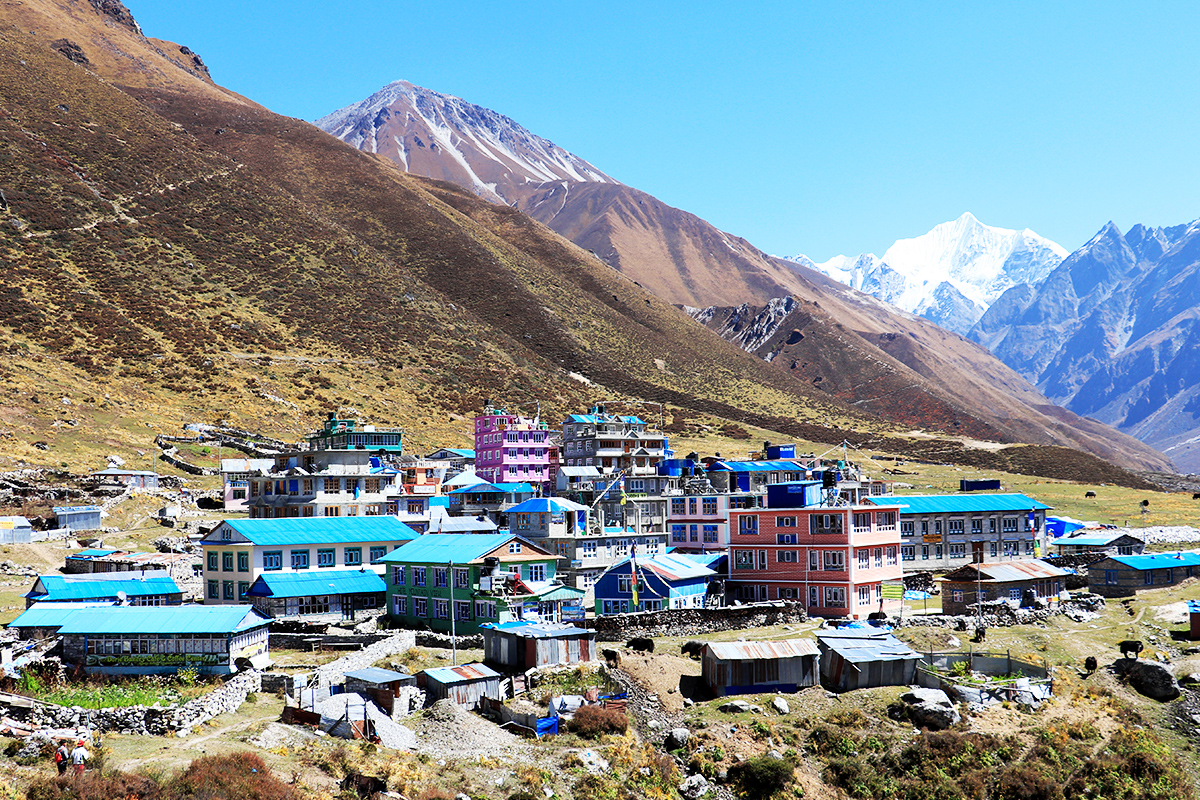
What is the best time to visit Langtang National Park?
Langtang National Park is the most classical and off-the-beaten trekking trail as you can visit the National Park around the year. But, scenery-wise, October to December ( which we normally called as autumn season) and May to July ( which we normally called as Spring season is the time to explore around the Langtang National Park. Normally, the National Park is more popular for the Langtang Valley Trek, and for trekking in Nepal's high mountains, the spring and autumn season is the best season.
Entry Fees & Permits for Langtang National Park
- SAARC countries Foreigners = NPR 1500 + 13%VAT/day
- Foreigners outside SAARC = NPR 3000 + 13%VAT/day
- Citizen: Free
- Children below 10 years: Free
How to get to Langtang National Park?
- By Jeep: Kathmandu - Surya Besi 4hrs
- By Bus: Kathmandu - Surya Besi 4hrs
- By Private Vehicle: Kathmandu - Suryabesi 2-3hrs
RARA NATIONAL PARK
Rara National Park is located in the Karnali district and is known as the smallest National Park of Nepal. It was established in 1976 A.D. at an altitude of 2,990m from sea level covering an area of 106sq.km. Even though the National Park is considered the smallest national park of Nepal due to its area but holds the biggest lake in Nepal i.e Rara Lake.
A Glance of Flora in Rara National Park
- More than 500 species of flowers.
- Sub-alpine and high temperate vegetation.
- Some common plants include pine, fir, and birch.
A Glance of Fauna in Rara National Park
- 20 species of mammals including musk deer, Himalayan black bear, leopard, jackal, Himalayan Thar, yellow-throated marten, marten, jackal, wild dog, red panda, etc.
- 214 species of birds including pheasants, grebes, common teal, red-crested, pochard, mallard, and gulls.
- Endangered wildlife found in the park is a Himalayan black bear, red panda, musk deer, leopard cat, Assamese monkey, grey wolf, etc.
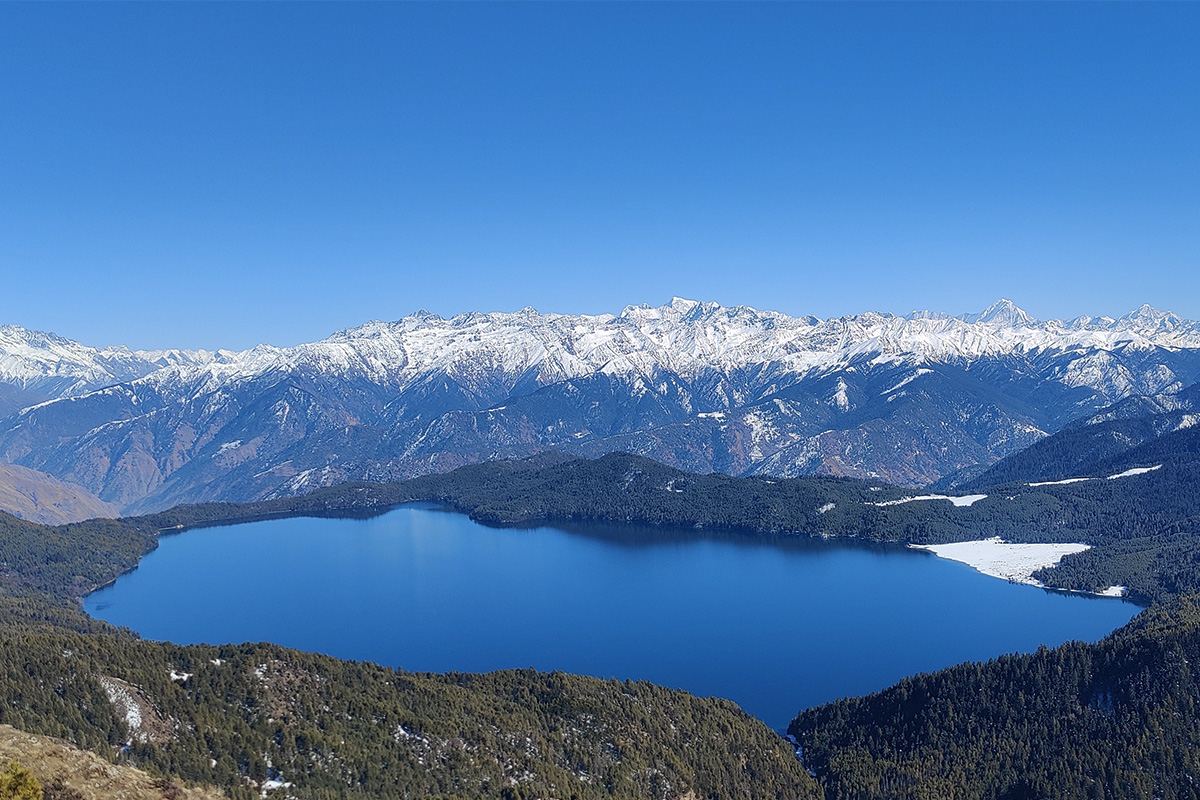
Things to do/explore in Rara National Park
- Trekking to Rara Lake/ National Park
- Boating
- Hiking to nearby Hills
- Sightseeing in Far West Nepal
- Jungle Safari
- Campfire
- Cycling
- Horse riding
What is the best time to visit Rara National Park?
Rara is basically popular for the lake and biodiversity which is available inside the National Park. Normally, April and May is the best month to explore the pristine Rara lake. However, if you go during monsoon, wildflower and high nature will amaze you. During the winter, snowy landscapes will be the best to experience in Rara National Park.
Permits & Entry Fee of Rara National Park
- SAARC countries Foreigners = NPR 1500 + 13%VAT/day
- Foreigners outside SAARC = NPR 3000 + 13%VAT/day
- Citizen: Free
- Children below 10 years: Free
How to get to Rara National Park?
- By Air: Kathmandu - Nepalgunj 1hr & Nepalgunj - Talcha or Jumla &5hr hike.
- By Bus: Kathmandu - Nepalgunj 12hr, Nepalgunj - Nagma whole day ride, and Nagma- Gamgadhi then Gamgadhi-Rara 5 hrs hike.
KHAPTAD NATIONAL PARK
Khaptad National Park known as the crown of the far-west is located in the Far-western region of Nepal was established in 1984 A.D. Situated at an altitude of 1,400m from sea level it covers an area of 225sq.km. Khaptad National Park is spread over Bajhang, Bajura, Doti, and Achham districts. Is said that here once lived an ascetic baba called “Khaptad Baba” whose statue you can witness while visiting the park.
A Glance of Flora in Khaptad National Park
- 3 vegetation zones are divided into sub-tropical, temperate, and alpine.
- Subtropical vegetation consists of landscape and montane sal, pine, and alder species forest.
- Temperate vegetation consists of lindera nacusua, Cinnamomum, tamca forest.
- Fir oak, birch, and rhododendron are the major species found here.
- 135 species of flower including primulas, buttercups, and wild berries.
- 224 species of medicinal herbs.
A Glance of Fauna in Khaptad National Park
- 20 species of mammals including barking deer, wild boar, goral, Himalayan black bear, yellow-throated marten, rhesus, and langur monkey.
- 266 species of migratory birds.
- 175 species of breeding birds.
- Impeyan pheasant (Dhanphe*- the national bird of Nepal), partridges, flycatchers, bulbuls, cuckoos, and eagles are some common birds found here.
- 23 species of amphibians and reptiles.
Things to do/explore in Khaptad National Park
- Trekking & Hiking
- Bird Watching & Wildlife Photography
- Cultural Tour
- Mountain Viewing
- Hunting trip
- Jeep tour
What is the best time to visit Khaptad National Park?
The beauty of the far-west can be explored all around the year with safety and proper guidance. But, in terms of scenery, easy accessibility and best view of landscapes, October to December ( which we normally called as autumn season) and May to July ( which we normally called as Spring season is the time to explore the Khaptad National Park.
Entry fee & Permits of Khaptad National Park
- SAARC countries Foreigners = NPR 1500+ 13%VAT/day
- Foreigners outside SAARC = NPR 3000 + 13%VAT/day
- Citizen: Free
- Children below 10 years: Free
How to get to Khaptad National Park?
By Air: Kathmandu - Dhangadhi 1hr20min & taxi to Bajhang 20 min and 2 days hiking.
SHEY-PHOKSUNDO NATIONAL PARK
Shey-Phoksundo National Park is the oldest and the largest National Park of Nepal covering an area of 3,555sq.km. This national park of Nepal was established in 1984 A.D at an altitude of 2,130 to 6,885m located in the western part of Nepal spread over Dolpa and mugu district. It was established in order to preserve the outstanding Trans-Himalayan ecosystem rich in flora and fauna of the country.
A Glance of Flora in Shey-Phoksundo National Park
- 286 species of ethnobotanical importance.
- Vegetation includes barren areas, upper Himalayas, and trans-Himalayan slope land.
- Less than 5% of the park is forested.
- Himalayan & Trans-Himalayan slope lands consist of rhododendron, caragana shrubs, salix, juniper, white Himalayan birch, and some occasional silver fir.
A Glance in Fauna in Shey-Phoksundo National Park
- Endangered species found here are snow leopard, grey wolf, musk deer, blue sheep, great Tibetan sheep, Himalayan Thar, leopard jackal, Himalayan black bear, etc.
- 200 species of birds including Tibetan partridge, wood snipe, white-throat tit, wood accentor, crimson-eared rosefinch, etc.
- 29 species of butterflies including the highest flying butterfly in the world i.c Paralasa Nepali.
- 6 species of reptiles.
Things to do/explore in Shey-Phoksundo National Park
- Phoksundo Lake trek
- Shey Gompa Trek
- Helitours over Park
- Dolpo Trek
- Upper Dolpo Trek
- Jeep tour
- Wildlife Photography
What is the best time to visit in Shey-Phoksundo National Park?
The beauty of west Nepal can be explored all around the year with safety and proper guidance. But, in terms of scenery, easy accessibility, and the best view of landscapes, October to December ( which we normally called as autumn season) and May to July ( which we normally called as Spring season is the time to explore the Shey-Phoksundo National Park.
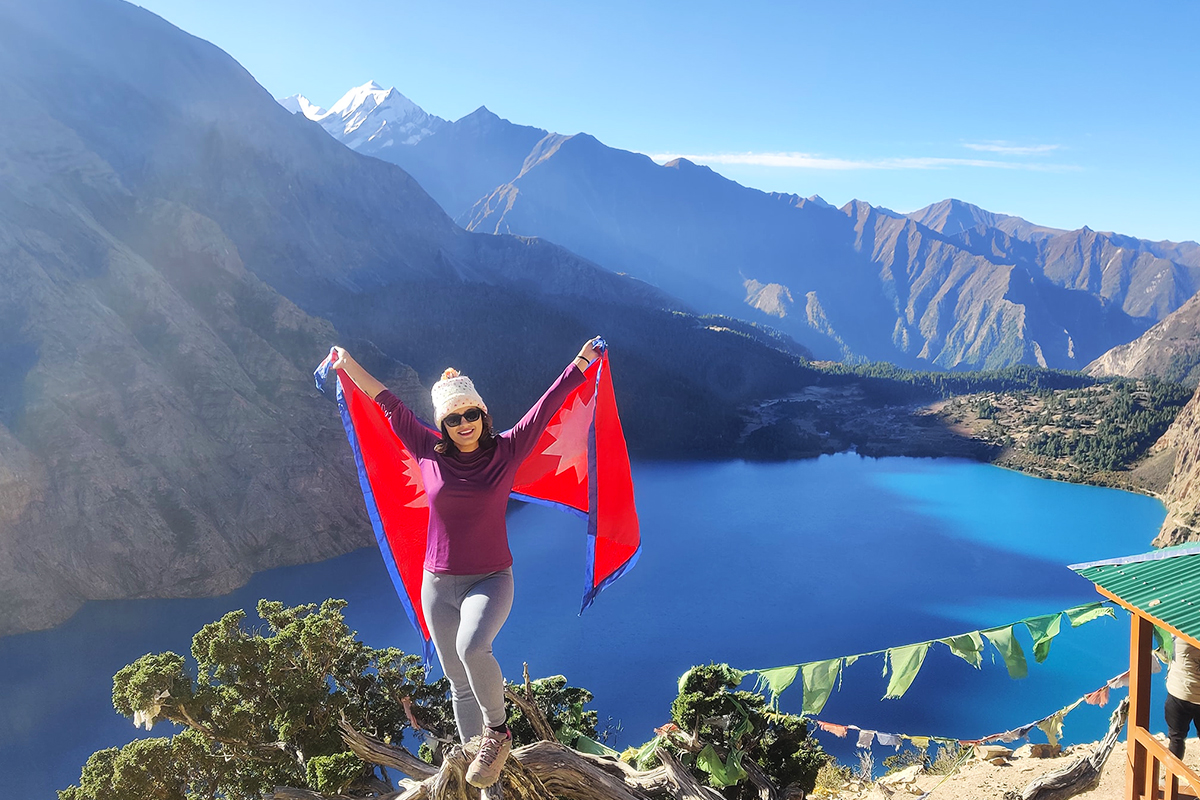
Entry fee/Permits in Shey-Phoksundo National Park
- SAARC countries Foreigners = NPR 1500 + 13%VAT/day
- Foreigners outside SAARC = NPR 3000 + 13%VAT/day
- Citizen: Free
- Children below 10 years: Free
How to get to the Shey-Phoksundo National Park?
- By Air: Kathmandu - Nepalgunj - Juphal Airport and the half a day walk to the national park.
- By Road: Surkhet-Jajarkot-Lower Dolpa
BARDIYA NATIONAL PARK
Bardiya National park is regarded as the largest national park of the western Terai region of Nepal covering a total area of 968sq.km at an altitude of 152m to 1441m. This national park is famous for royal Bengal tigers and Asian elephants. It was established in 1976 A.D. and it is said that there once lived the largest Asian elephant called “Raja Gaj '' (1936-2007) and suddenly disappeared after that. It is the only national park consisting of the highest numbers of royal Bengal tigers.
A Glance of Flora in the Bardiya National Park
- 70% of the area is forested including sal trees with a mixture of grassland.
- Vegetation includes reverie forest and savannah-type grassland.
- 839 species of plants
- 173 of them are vascular plants
A Glance of Fauna in the Bardiya National Park
- 30 species of mammals
- 230 species of birds
- Endangered birds found there are Bengal florican, lesser florican, and sarus crane.
- 150 species of reptiles.
- Endangered animals found here are rhinoceros, wild elephant, royal Bengal tiger, swamp deer, blackbuck, gharial crocodile, marsh mugger crocodiles, and Gangetic dolphins.
- 125 species of fish.
Things to do/explore in Bardiya National Park
- Jungle walk
- Jeep safari
- Elephant safari
- Rafting in Karnali River
- Elephant Breeding center
- Crocodile breeding center
- Tharu Museum
- Stay in eco-lodges & local homestay
- Sunset at Karnali River
- Tiger sightseeing tour
- Bird watching
- Wildlife Photography
What is the best time to visit Bardiya Nationa Park?
The National Park lies in the lower Terai belt, so morally you can explore from September to December in the Autumn season and February to May in the early spring season. This is the time when you can experience mostly wildlife and their close encounter. During the monsoon, the trail is covered with bushes and grassed and it's quite slippery as well.
Entry Fee & Permits of Bardiya National Park
- SAARC countries Foreigners = NPR 500 + 13%VAT/day
- Foreigners outside SAARC = NPR 1000 + 13%VAT/day
- Citizen: NPR 50 + 13%VAT/day
- Children below 10 years: Free
How to get to Bardiya National Park?
- By Air: Kathmandu - Bharatpur 20min
- By Bus: Kathmandu - National Park 5+hrs
- By Private Vehicle: Kathmandu - National Park 5+hrs
MAKALU BARUN NATIONAL PARK
Makalu Barun National Park was previously known as Makalu Conservation Area established in 1992 A.D is also called aa one of the “Beyul” in Buddhist literature. This means of all the places being destroyed this part of the world will remain untouched. Makalu National Park shields an area of 2,330sq.km at an altitude of 8000m from sea level and is situated in the Sankhuwasabha and Solu-Khumbu district of Nepal sharing its border with Sagarmatha national park.
A Glance of Flora in Makalu Barun National Park
- 25 species of rhododendron.
- 47 species of orchid,
- 56 species of rare plants.
- 19 species of bamboo.
- 15 varieties of oaks.
- 27 types of forest.
A Glance of Fauna in Makalu Barun National Park
- 88 species of mammals including snow leopard, Indian leopard, clouded leopard, black bear, hanuman langur, Assam macaque, Himalayan goral, musk deer. Himalayan serow, flying squirrel, golden jackal, Himalayan wolf, red fox, jungle cat, etc.
- 433 species of birds including a rose-ringed parakeet, Blyth's kingfisher, deep-blue kingfisher, blue napped pitta, pale blue flycatcher, sultan tit, silver-eared mesia, etc.
- 78 species of fish.
- 43 species of reptiles.
- 16 species of amphibians.
- 315 species of butterfly.
- Endangered animals found in the parks are red-panda, musk deer, Himalayan black bear, clouded leopard, and snow leopard.
Things to do/explore in Makalu Barun National Park
- Bird watching & Snow Leopard tracks.
- Trekking to Barun valley and Makalu Base Camp
- Peak climbing and Expedition of Mt. Makalu
- Religious tour in Shiva Dhara
- Wildlife and mountain Photography
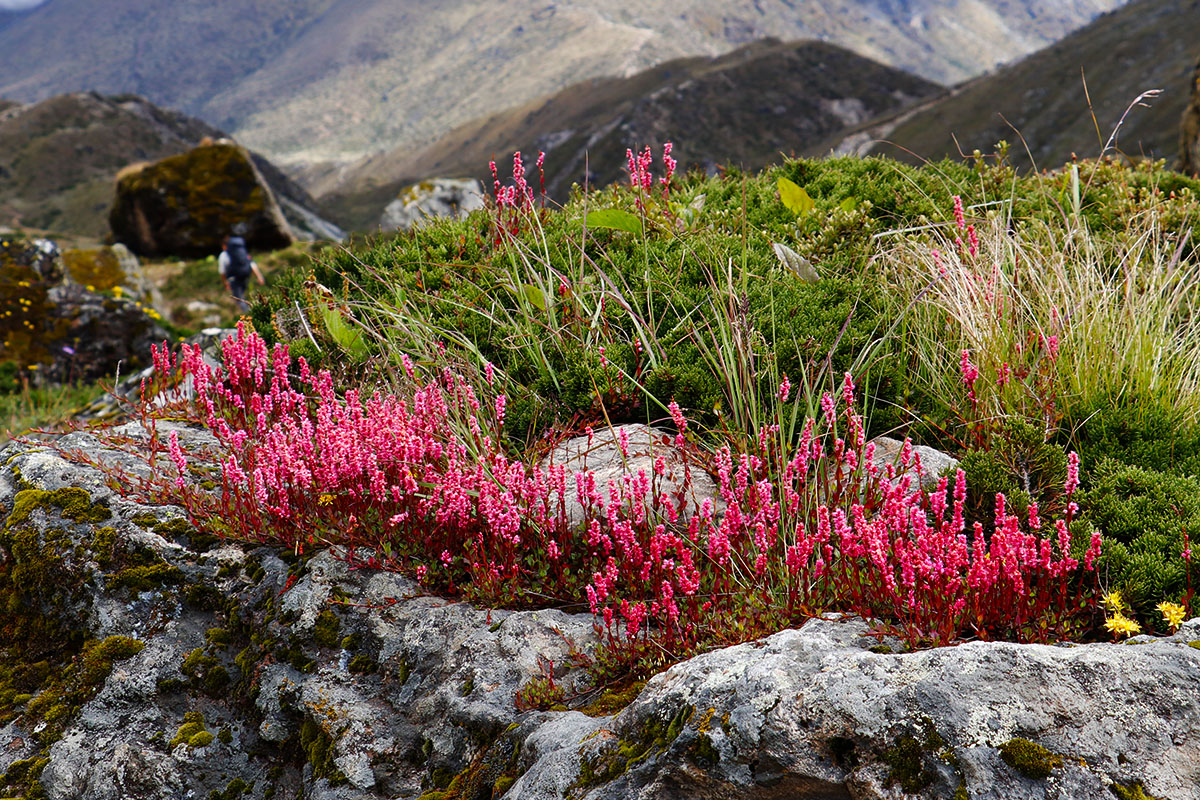
When is the best time to visit Makalu Barun National Park?
Makalu Barun region is one of the most exotic along with off-the-beaten, undiscovered virgin land in the eastern-Nepal. You can explore around the year in the Makalu Barun region but in terms of scenic views, mountains range in a clear sky and high form of nature, you can explore in early autumn ( June to September) and early winter (December to January). Also for the trekking and high mountain activities in this region ( March to May) Spring and (October to December) Autumn is the best season for the good weather, clear views of mountains, and warm temperature.
Entry fee and Permits of Makalu Barun National Park
- SAARC countries Foreigners = NPR 1500 + 13%VAT/day
- Foreigners outside SAARC = NPR 3000 + 13%VAT/day
- Citizen: Free
- Children below 10 years: Free
How to get to Makalu Barun National Park?
- By Air: Kathmandu - Tumlingtar Airport 20min
- By Bus: Kathmandu - National Park 5+hrs
- By Private Vehicle: Kathmandu - National Park 5+hrs
SHIVAPURI NAGARJUN NATIONAL PARK
Shivapuri Nagarjun National Park is the only national park of Nepal that lies in the capital city Kathmandu declared in 2002 A.D. Covering an area of 159sq.km this national park is situated at an altitude of 2,732m from sea level spread over the parts of Kathmandu, Nuwakot, Sindhupalchowk, and some parts of Dhading Districts.
A Glance of flora in Shivapuri National Park
- Provides 40% of drinking water to Kathmandu Valley.
- occupies 39% of the land.
- 129 species of mushrooms.
- Vegetation including pine, oak, rhododendron, etc.
A Glance of fauna in Shivapuri National Park
- 19 species of mammals including Himalayan black bear, leopard, jungle cat, and rhesus monkey.
- 9 species of birds.
- 150 species of butterflies.
- Endangered species found in the park are clouded leopard, pangolin, Assamese monkey, and leopard cat.
Things to do/explore in Shivapuri National Park
- One day hiking
- Bird watching
- Mountain biking
- Motorbike tour
- Trekking
- Rock climbing
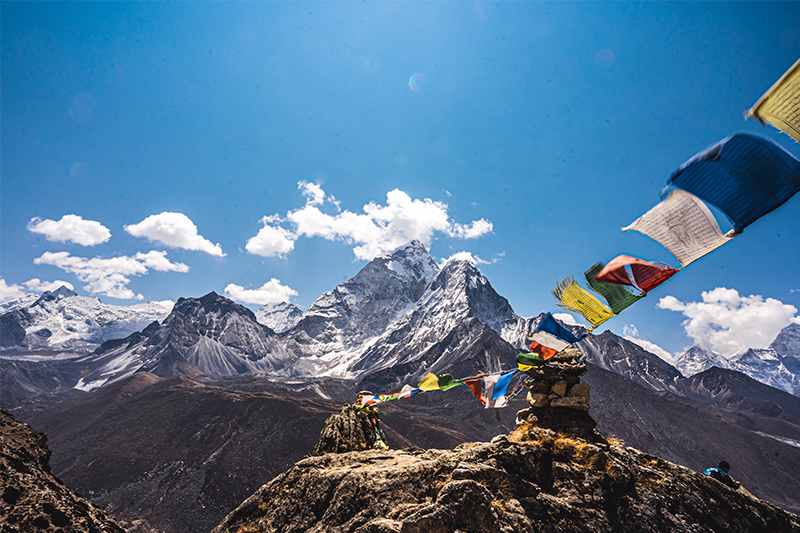
When is the best time to visit Shivapuri National Park?
This National Park lies close to Kathmandu, so you can go and explore around the year. But, still for the scenic views and high form of nature March to June in Spring and Sept to December during autumn is the best season to explore inside the Shivapuri National Park.
Entry fee & Permits for Shivapuri National Park
- SAARC countries Foreigners = NPR 500 + 13%VAT/day
- Foreigners outside SAARC = NPR 1000 + 13%VAT/day
- Citizen: NPR 50 + 13%VAT/day
- Children below 10 years: Free
How to get to the Shivapuri National Park?
- By Bus: Kathmandu - National Park 8+hrs
- By Private Vehicle: Kathmandu - National Park 8+hrs
BANKE NATIONAL PARK
Banke National park is the nearest national park sharing its borders with Bardiya national park toward the west further leading to Katarniaghat Wildlife Sanctuary in India and linking it transboundary with Suhelwa Wildlife Sanctuary in India. Banke national park was established in 2010 A.D located in parts of Banke, Dang, and Salyan district covering an area of 550sq.km.
A Glance of flora in Banke National Park
- 124 species of plants.
- 90% of the area is a natural forest consisting of mainly sal, karma, Khair, and sissoo
- 113 species of trees including sal, and axle wood.
- 107 species of herbs.
- 85 species of shrubs and climbers.
A Glance of Fauna in Banke National Park
- 34 species of mammals.
- 300 species of birds
- 24 species of reptiles
- 7 species of amphibians
- 58 species of fish
- Endangered species of mammals found in the park are tiger, striped hyena, four-horned antelope, and Asiatic elephant.
- Endangered species of birds found in the park are giant hornbill, black stork, Bengal florican, and lesser florican.
- Endangered reptiles found in the park are gharial crocodiles and pythons.
Things to do/explore in Banke National Park
- Hiking and Jungle walk
- Jungle safari
- Boating & Cycling
- Birdwatching & Sightseeing
- Nature walking Tour
- Wildlife photography
When is the best time to visit Banke National Park?
The National Park lies in the lower Terai belt, so morally you can explore from September to December in the Autumn season and February to May in the early spring season. This is the time when you can experience mostly wildlife and their close encounter. During the monsoon, the trail is covered with bushes and grassed and it's quite slippery as well.
Entry fee & Permits of Banke National Park
- SAARC countries Foreigners = NPR 200+ 13%VAT/day
- Foreigners outside SAARC = NPR 500 + 13%VAT/day
- Citizen: NPR 20 + 13%VAT/day
- Children below 10 years: Free
How to get to Banke National Park
- By Air: Kathmandu - Bharatpur 20min
- By Bus: Kathmandu - National Park 5+hrs
- By Private Vehicle: Kathmandu - National Park 5+hrs
SHUKLAPHANTA NATIONAL PARK
Shuklaphata National Park was established as a wildlife reserve in 1967 and later declared as the National Park of Nepal in 2017. This National Park covers an area of 305sq.km and is situated in Kanchanpur District of Terai at an altitude of 174m- 1,386m from sea level sharing its border with Uttar Pradesh, a state in India.
A Glance of flora in Shuklaphanta National Park
- 52% area covered by sal trees
- 10% area covered with wetland & 30% grassland.
- 16% of an area is a riverside forest consisting of Sal, khair, and sissoo.
- 2% consist of mixed forest
- 700 species of plants.
A Glance of the fauna in the Shuklaphanta National Park
- 24 species of mammals including 2301 swamp deer, 16 Bengal tigers, sloth bears, 20-25 elephants, Indian leopard, hispid hare, great one-horned rhinoceros, etc.
- 350 species of birds including dusky eagle owl, great slaty woodpecker, chestnut-capped babbler, sarus crane, rusty-tailed flycatcher, etc.
- 180 breeding species.
- 14 species of fish including rohu, mahaseer, and tenger.
- 12 reptiles and amphibians.
- Endangered animals like Royal Bengal Tiger, Indian leopard, swamp deer, hispid hare, sloth bear, and one-horned rhinoceros.
Things to do/explore in Shuklaphanta National Park
- Jungle Safari and Nature Walk
- Elephant safari
- Bird watching
- Cultural sightseeing
- Rani Tal inside the national park
- Nature walking
When is the best season to visit Shuklaphanta National Park?
The National Park lies in the lower Terai belt, so morally you can explore from September to December in the Autumn season and February to May in the early spring season. This is the time when you can experience mostly wildlife and their close encounter. During the monsoon, the trail is covered with bushes and grassed and it's quite slippery as well.
Entry fee & Permit
- Guide Charge: NPR 1050 and NPR 2000
How to get into the Shuklaphanta National Park?
- By Air: Kathmandu - Bharatpur 20min
- By Bus: Kathmandu - National Park 5+hrs
- By Private Vehicle: Kathmandu - National Park 5+hrs
PARSA NATIONAL PARK
Also established as a wildlife Reserve in 1984A.D covering an area of 488sq.km at an altitude of 432m- 950m Parsa National Park is situated at the plains of Terai is located in Bara and Makwanpur district of Nepal. For over the years Parsa National Park was established to preserve Asian Wild Elephants and their remaining habitat. This 12th National park of Nepal is adjacent to Chitwan National Park of Nepal and Valmiki National Park of India.
A Glance of flora in the Parsa National Park
- 90% vegetation consists of tropical, sub-tropical, and sal forest.
- 919 species of flora.
- 289 species of vascular Plants
- 234 dicots, 58 monocots, 5 pteridophyte, and 1 gymnosperm.
- Hills covered by Chir pine, Khair, Sissoo, and Silk-cotton trees.
A Glance of fauna in the Parsa National Park
- Endangered species include wild Asian elephants, Royal Bengal Tiger, Sloth bear, and Leopard.
- Mammals found are blue bull, sambar, chital, hog deer, barking deer, langur, rhesus macaques, striped hyena, jungle cat, palm civet, etc.
- 500 species of birds including giant hornbills, white-breasted kingfisher, Paradise flycatcher, golden-backed woodpecker, etc.
- Reptiles found here include common cobra, banded krait, rock python, and king cobra.
Things to do/explore in the Parsa National Park
- Jungle safari and Nature walk
- Jeep safari
- Sightseeing
- Elephant safari
- Wildlife Photography
When is the best time to visit Parsa National Park?
The Parsa National Park lies in the lower Terai belt, so morally you can explore from September to December in the Autumn season and February to May in the early spring season. This is the time when you can experience mostly wildlife and their close encounter. During the monsoon, the trail is covered with bushes and grassed and it's quite slippery as well. If you are going for wildlife photography, post-monsoon to early autumn would be the best season for Parsa National Park.
Entry fee & Permits
- SAARC countries Foreigners = NPR 500 + 13%VAT/day
- Foreigners outside SAARC = NPR 1000 + 13%VAT/day
- Citizen: NPR 50 + 13%VAT/day
- Children below 10 years: Free
How to get to the Parsa National Park?
- By Air: Kathmandu - Simara 15 min
- By Bus: Kathmandu - Simara 6hr 48min
- By Private Vehicle: Kathmandu - Simara 3hr23min.









